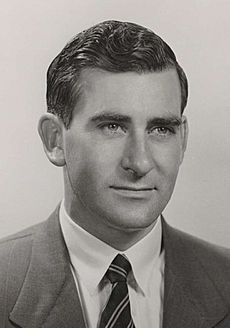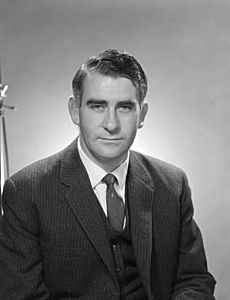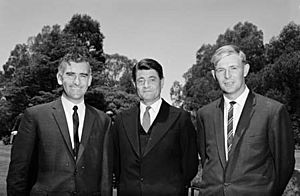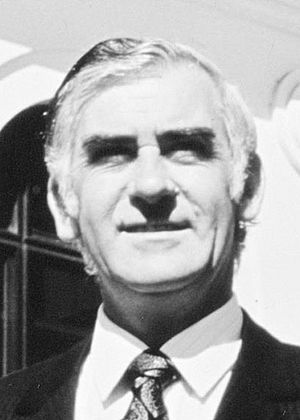Billy Snedden facts for kids
Quick facts for kids
Sir Billy Snedden
|
|||||||||||||||||||||||||||||||||||||||||||||||||||||||||||||
|---|---|---|---|---|---|---|---|---|---|---|---|---|---|---|---|---|---|---|---|---|---|---|---|---|---|---|---|---|---|---|---|---|---|---|---|---|---|---|---|---|---|---|---|---|---|---|---|---|---|---|---|---|---|---|---|---|---|---|---|---|---|
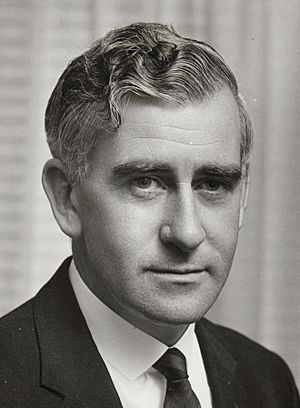
Snedden in 1967
|
|||||||||||||||||||||||||||||||||||||||||||||||||||||||||||||
| Leader of the Opposition | |||||||||||||||||||||||||||||||||||||||||||||||||||||||||||||
| In office 20 December 1972 – 21 March 1975 |
|||||||||||||||||||||||||||||||||||||||||||||||||||||||||||||
| Prime Minister | Gough Whitlam | ||||||||||||||||||||||||||||||||||||||||||||||||||||||||||||
| Deputy | Phillip Lynch | ||||||||||||||||||||||||||||||||||||||||||||||||||||||||||||
| Preceded by | Gough Whitlam | ||||||||||||||||||||||||||||||||||||||||||||||||||||||||||||
| Succeeded by | Malcolm Fraser | ||||||||||||||||||||||||||||||||||||||||||||||||||||||||||||
| Speaker of the House of Representatives | |||||||||||||||||||||||||||||||||||||||||||||||||||||||||||||
| In office 17 February 1976 – 4 February 1983 |
|||||||||||||||||||||||||||||||||||||||||||||||||||||||||||||
| Preceded by | Gordon Scholes | ||||||||||||||||||||||||||||||||||||||||||||||||||||||||||||
| Succeeded by | Harry Jenkins Sr. | ||||||||||||||||||||||||||||||||||||||||||||||||||||||||||||
|
|||||||||||||||||||||||||||||||||||||||||||||||||||||||||||||
|
|||||||||||||||||||||||||||||||||||||||||||||||||||||||||||||
|
|||||||||||||||||||||||||||||||||||||||||||||||||||||||||||||
| Personal details | |||||||||||||||||||||||||||||||||||||||||||||||||||||||||||||
| Born |
Billy Mackie Snedden
31 December 1926 West Perth, Western Australia, Australia |
||||||||||||||||||||||||||||||||||||||||||||||||||||||||||||
| Died | 27 June 1987 (aged 60) Rushcutters Bay, New South Wales, Australia |
||||||||||||||||||||||||||||||||||||||||||||||||||||||||||||
| Political party | Liberal | ||||||||||||||||||||||||||||||||||||||||||||||||||||||||||||
| Spouse |
Joy Forsyth
(m. 1950) |
||||||||||||||||||||||||||||||||||||||||||||||||||||||||||||
| Children | 4 | ||||||||||||||||||||||||||||||||||||||||||||||||||||||||||||
| Education | Highgate State School Perth Boys' School Perth Technical College |
||||||||||||||||||||||||||||||||||||||||||||||||||||||||||||
| Alma mater | University of Western Australia | ||||||||||||||||||||||||||||||||||||||||||||||||||||||||||||
| Occupation | Commercial lawyer Public servant Politician |
||||||||||||||||||||||||||||||||||||||||||||||||||||||||||||
Sir Billy Mackie Snedden (born 31 December 1926 – died 27 June 1987) was an important Australian politician. He led the Liberal Party from 1972 to 1975. He also served as a government minister and later as the Speaker of the House of Representatives.
Billy Snedden was born in Perth, Western Australia. He joined the Royal Australian Air Force during World War II. After the war, he studied law at the University of Western Australia. From 1951 to 1952, he was the first national leader of the Young Liberal Movement. He worked overseas for a short time before returning to Australia in 1954. He was elected to the House of Representatives in 1955 when he was 28 years old.
In 1964, Billy Snedden became a minister in the government under Prime Minister Robert Menzies. He held several important roles until the Liberal government lost the election in 1972. He was the Attorney-General (1964–1966), Minister for Immigration (1966–1969), Minister for Labour and National Service (1969–1971), and Treasurer (1971–1972). In 1971, he became the deputy leader of the Liberal Party. After the 1972 election loss, he became the leader of the Liberal Party and the Leader of the Opposition.
Billy Snedden led the Liberal Party in the 1974 federal election. The Labor Party won again, but with a smaller majority. Malcolm Fraser challenged Snedden's leadership twice in 1975 and won the second time. Later that year, Fraser became Prime Minister. Billy Snedden was then elected as the Speaker of the House of Representatives. He held this position for almost seven years and was known for being fair. After retiring from politics, he was involved with the Melbourne Football Club and the Victorian Football League. He passed away in 1987.
Contents
Early Life and Education
Growing Up in Perth
Billy Snedden was born on 31 December 1926 in West Perth, Western Australia. He was the youngest of six children. His parents, Catherine and Alan Snedden, were from Scotland. They moved to Australia in 1912 with their older children.
The family first lived in a mining town called Meekatharra. They moved to Perth around 1921. Billy's father worked as a stonemason and sometimes as a miner. Billy grew up in Perth's inner north. His oldest brother, Bob, became the main provider for the family. Billy's mother worked as a laundress.
Billy started working part-time when he was about eight. He helped his brothers on building sites. He also sold and delivered newspapers. He went to Highgate Primary School. Later, he attended Perth Boys' School until ninth grade.
School and Sports
In April 1942, Billy left school. He started working as a junior law clerk. This job was usually for older students. But because of the war, there weren't many applicants. Billy later earned his leaving certificate by going to night school. He attended Perth Technical College.
Billy was a good sportsman when he was young. He played a few games for the West Perth Football Club in 1944. He also represented Western Australia in football in 1951.
Military Service and University
Billy tried to join the military several times. He joined the Royal Australian Air Force (RAAF) in January 1945. He was 18 years old. He started air crew training. But the war ended soon after. He was then given general duties. He was discharged from the RAAF in September 1945.
After the war, tests showed Billy was good for university. He started studying law at the University of Western Australia in 1946. He graduated with a law degree in 1950. He became a lawyer in December 1951.
Starting a Career
In 1951, Billy Snedden worked briefly for the Commonwealth Crown Solicitor's office. He then worked as a hearing aid salesman. In 1952, he got a job as a migration officer. This was with the Department of Immigration.
He and his family moved to Italy for 16 months. They lived in Taormina and Rome. He learned to speak Italian. He interviewed people who wanted to move to Australia. In 1953, he was transferred to England. After a year, he decided to return to Australia. In 1955, he moved to Melbourne. He worked in a legal office helping former service members. He and his family settled in Ringwood.
Political Journey
Early Steps in Politics
Billy Snedden was very active in politics from a young age. He was the state president of the Young Liberals. From 1951 to 1952, he was the first national chairman of the Young Liberal Movement. At university, he met Bob Hawke, who would also become a future prime minister.
Before being elected, Billy tried three times to enter politics. He ran for the Liberal Party in state and federal elections.
Becoming a Member of Parliament
In 1954, Billy Snedden moved to Melbourne. He worked as a lawyer there. In 1955, he was elected to the House of Representatives. He represented the area of Bruce. He won against the Labor candidate, Keith Ewert.
In the 1961 election, Billy Snedden faced Ewert again. It was a very close election. Billy Snedden won by a small number of votes. His win was very important. It helped the Coalition government stay in power. This was one of the closest elections in Australia's history.
Serving as a Cabinet Minister
Billy Snedden served in the governments of several Prime Ministers. These included Sir Robert Menzies, Harold Holt, John McEwen, John Gorton, and William McMahon. In March 1964, Menzies made him the Attorney-General. This is the government's chief legal advisor.
As Attorney-General, he played a role in the 1967 constitutional referendum. This vote changed parts of the Australian Constitution. It removed old rules that excluded Aboriginal people from population counts. It also allowed the federal government to make laws for Aboriginal people. The referendum was strongly supported by Australians.
He was the Minister for Immigration from 1966 to 1969. Then he became the Minister for Labour and National Service from 1969 to 1971. In this role, he was in charge of the government's national service policy. In 1967, he was a candidate for the Liberal Party leadership after Harold Holt died.
In 1971, Billy Snedden was appointed Treasurer by Prime Minister William McMahon. This role manages the country's money. He also became the Deputy Leader of the Liberal Party. This made him a strong candidate to become the next leader.
Leading the Opposition
In 1972, the Liberal government lost the election to the Labor Party, led by Gough Whitlam. Billy Snedden was then elected as the new leader of the Liberal Party. This made him the Leader of the Opposition. He won by just one vote.
Billy Snedden wanted to make the Liberal Party more modern. In 1974, he decided to use the Liberal Party's majority in the Senate to block the government's budget. This meant the government could not spend money. Whitlam then called for a new election. This was a "double dissolution" election on 18 May 1974. The Labor Party won again, but with a smaller majority.
After the election, some members of the Liberal Party, led by Malcolm Fraser, challenged Snedden's leadership. Billy Snedden was re-elected by a small margin. But when he couldn't gain ground against Whitlam, Fraser challenged him again. In March 1975, Billy Snedden was replaced as leader. He was the first Liberal Party leader who did not become Prime Minister. He then served as a regular Member of Parliament until February 1976.
Becoming Speaker of the House
On 17 February 1976, Billy Snedden was elected Speaker of the House of Representatives. The Speaker is like an umpire in Parliament. They make sure debates follow the rules. He was re-elected as Speaker in 1978 and 1980.
He was the last Speaker to wear the traditional wig and gown. He believed this would help bring dignity to the role. As Speaker, Billy Snedden wanted to make the role more independent. He thought the Speaker should be a fair umpire, like in the British Parliament. He suggested that the Speaker should stay in office for several years. He also thought the Speaker should not be opposed by major parties in elections. And that the Speaker should leave their political party when they become Speaker.
He also worked to make Parliament more independent from the government. He believed Parliament should control its own money. This led to new laws about the Parliament's budget.
One famous event happened in February 1982. A Labor politician, Bob Hawke, called Prime Minister Malcolm Fraser a "liar" during question time. Billy Snedden asked Hawke to take back the remark. When Hawke refused, Snedden had to follow parliamentary rules. He tried to suspend Hawke from Parliament. But many other opposition members also started calling Fraser a "liar." Billy Snedden realized that suspending everyone would stop Parliament from working. So, he decided not to put the motion to a vote.
Fraser was very angry. He tried to make Snedden punish Hawke. But Snedden refused. He believed he was being fair. He thought Fraser was causing the problem. Snedden was worried he might be replaced as Speaker. But Fraser realized he didn't have enough support to remove Snedden.
When the Fraser government lost the election in 1983, Billy Snedden resigned from Parliament. He did this to follow his own ideas about the Speaker's role. He believed that when a Speaker leaves their role, they should also leave Parliament. He formally resigned on 21 April 1983.
Later Life and Legacy
After leaving Parliament in 1983, Billy Snedden retired from public life. He was the Chairman of the Melbourne Football Club from 1981 to 1986. He also served as a Director of the Victorian Football League.
Billy Snedden passed away on 27 June 1987 in Sydney. He was 60 years old.
Honours
Billy Snedden received several honours for his service. He was appointed a Knight Commander of the Order of St Michael and St George (KCMG) in January 1978. This is a special honour given by the Queen. He also became a Privy Councillor in 1972.
Images for kids
See also
 In Spanish: Billy Snedden para niños
In Spanish: Billy Snedden para niños


